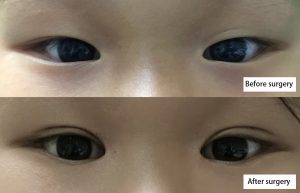- 2019/12/14
- Others
Does my child has esotropia?
Parents often bring their child to the clinic on suspicion of esotropia, but after examinations, it’s due to medial epicanthus, which means too much skin inside the eye and looks like cockeyes.
At the junction of upper and lower eyelids, the outer corner of the eye is called the lateral canthus, the inner corner of the eye is called the medial canthus. Asians’ excessive skin folds over medical canthus is called medial epicanthus, which is also called “Mongolian folds.” Too many epicanthic folds will cover the inner white of the eye, looking like cockeyes. With age, the nasal bone becomes taller, face shape longer, baby fat lost, so the medial canthus will become shorter with the inner white of the eye gradually exposed, improving cockeyes. In this situation, there’s no need to have any treatment, but only when severe trichiasis occurs, a necessary surgical treatment will shorten the medial epicanthus (similar to the medial epicanthoplasty method). In the photo is a little patient with trichiasis, and originally the inner white of the eye couldn’t be seen, but after opening the medial epicanthus, they don’t look like cockeyes anymore!
Not all cockeyes result from the medial epicanthus. Some are real esotropia, so it’s necessary to have them examined and assessed thoroughly at an ophthalmology clinic.







COMMENTS
In order top protect personal privacy,the message will be determined according to the situation.※is required field.
共0則留言